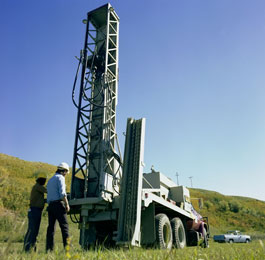What is natural gas?
Natural gas occurs deep beneath the earth's surface. Natural gas consists mainly of methane, a compound with one carbon atom and four hydrogen atoms. Natural gas also contains small amounts of hydrocarbon gas liquids and nonhydrocarbon gases. We use natural gas as a fuel and to make materials and chemicals.
How did natural gas form?
Millions of years ago, the remains of plants and animals (diatoms) decayed and built up in thick layers, sometimes mixed with sand and silt. Over time, these layers were buried under sand, silt, and rock. Pressure and heat changed some of this organic material into coal, some into oil (petroleum), and some into natural gas. In some places, the natural gas moved into large cracks and spaces between layers of overlying rock. In other places, natural gas occurs in the tiny pores (spaces) within some formations of shale, sandstone, and other types of sedimentary rock, where it is referred to as shale gas or tight gas. Natural gas also occurs in coal deposits, where it is called coalbed methane.

Source: U.S. Energy Information Administration (public domain)
How do we get natural gas?
Did you know?
Because natural gas is colorless, odorless, and tasteless, natural gas companies add mercaptan to natural gas to give it a distinct and unpleasant odor to help detect leaks in natural gas pipelines. Mercaptan is a harmless chemical that smells like rotten eggs.

Source: Stock photography (copyrighted)
The search for natural gas begins with geologists who study the structure and processes of the earth. They locate the types of rock that are likely to contain natural gas deposits. Some of these areas are on land and some are offshore and deep under the ocean floor.
Geologists often use seismic surveys on land and in the ocean to find the right places to drill oil and natural gas wells. Seismic surveys on land use echoes from a vibration source at the surface of the earth, usually a vibrating pad under a special type of truck. Geologists can also use small amounts of explosives as a vibration source. Seismic surveys conducted in the ocean rely on blasts of sound that create sonic waves to explore the geology beneath the ocean floor.
If a site seems promising, an exploratory well is drilled and tested. Once a formation is proven to be economic for production, one or more production (or development) wells are drilled down into the formation, and natural gas flows up through the wells to the surface. In the United States and a few other countries, natural gas is produced directly from shale and other types of rock formations that contain natural gas in pores within the rock. The rock formation is fractured by forcing water, chemicals, and sand down a well. This process releases the natural gas from the rock, and the natural gas flows up the well to the surface. Wells drilled to produce oil may also produce associated natural gas.
The natural gas withdrawn from a well is called wet natural gas because it usually contains liquid hydrocarbons and nonhydrocarbon gases. Methane and other useful gases are separated from the wet natural gas near the site of the well or at a natural gas processing plant. The processed natural gas is called dry or consumer-grade natural gas. This natural gas is sent through pipelines to underground storage fields or to distribution companies and then to consumers.
Coal deposits may contain coalbed methane, which can be captured when coal is mined. Coalbed methane can be added to natural gas pipelines without any special treatment. Another source of methane is biogas, which forms in landfills and in vessels called digesters.
Most of the natural gas consumed in the United States is produced in the United States. Some natural gas is imported from Canada and Mexico in pipelines. A small amount of natural gas is also imported as liquefied natural gas.



